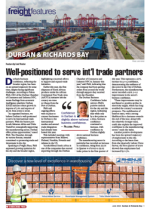Progress towards bolstering operations and enhancing service delivery at the Port of Durban is well under way as Transnet Port Terminals (TPT) persists in its efforts to stabilise the operating environment at the country’s busiest port.Speaking to Freight News, Earle Peters, managing executive of the D u r b a n Te r m i n a l s , said the past six months had seen a major focus on implementing the recovery plan to restore operations and alleviate bottlenecks after massive disruptions in 2023 resulted in extensive delays and substantial congestion.“Over the past six months we have been very focused on the recovery plan that has emphasised critical container handling equipment availability and reliability,” he said. “At Pier 2 we have been working to introduce the renewal of the container handling fleet, particularly the ship-to-shore cranes and straddle carr iers.”With the second phase of the recovery plan introduced on April 1, efforts have intensified to keep the momentum going and address some serious challenges at the port. “At Pier 1, over the next six months we are focusing on renewing the RG f leet. All our initiatives and plans are around creating the capability to turn vessels around more quickly. This is particularly important as we head into the big reefer season.”The South African citrus season kicked off in April, with the movement of lemons, grapefruit and other early soft citrus. According to the Citrus Growers’ Association (CGA), an increase in citrus export volume is expected this season, making it imperative for the port to be f luid and move the perishables as quickly as possible. First forecasts for the 2024 season include a 7% increase in lemon volumes, 12% for Valencia oranges and 14% for grapefruit.This puts even more pressure on Transnet to ensure port operations are running optimally and can handle the increased volume. “We are very confident in the capabilities at Pier 1 and Pier 2,” said Peters, indicating that initiatives to address the massive challenges were bearing fruit, enabling the terminal to refocus on its growth strategy. “We are expecting bumper crops from the agriculture sector and have worked hard to ensure we can provide sustainability and reliability to this sector. The same applies to the automotive sector. Both are crucial industries, as are manufacturing supply chains. We understand the importance of Transnet in supporting the country's financial stability and will continue working towards delivering the logistics solutions the country needs. Investment in expanding our operations and increasing capacity is now receiving more attention.”He said equipment remained a challenge, much as it had in 2023, although contingency plans had improved dramatically. “Equipment will remain under pressure at the port until our new equipment is delivered and commissioned, starting from October this year. In the meantime, we have ensured that we can address equipment failures more quickly with shorter procurement processes for spare parts and are working closely with original equipment manufacturers to reduce downtime.”But, said Peters, there was much optimism for the Port of Durban. For the longest time, shipping lines were considered our primary customers, but we have expanded that outlook and are now much more in touch with the end-users. This required us to step out of our comfort zone and engage more widely and regularly with a range of stakeholders. This approach has brought many benefits, and we are hopeful that the relationships we have built will continue to support us in meeting the industry's expectations.”

